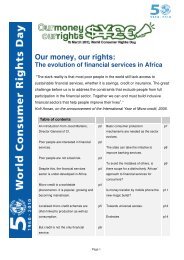Voices for Change: the Consumer Right to Representation
Voices for Change: the Consumer Right to Representation
Voices for Change: the Consumer Right to Representation
You also want an ePaper? Increase the reach of your titles
YUMPU automatically turns print PDFs into web optimized ePapers that Google loves.
World <strong>Consumer</strong> <strong>Right</strong>s Day 2002: <strong>Voices</strong> <strong>for</strong> <strong>Change</strong><br />
4 Making it Real: Strategies <strong>for</strong><br />
Effective <strong>Representation</strong><br />
CI’s 1988 WCRD kit, Doing It Ourselves,<br />
suggested this <strong>for</strong>mula <strong>for</strong> consumer<br />
representation: “As a consumer group,<br />
your role with politicians, government<br />
officials, elected representatives and<br />
ministers is ambiguous. You must maintain<br />
a delicate balance. You must make friends<br />
and influence people among <strong>the</strong> powersthat-be.<br />
But you must also be an irritant,<br />
a gadfly, continually pressing <strong>for</strong><br />
improvements <strong>to</strong> <strong>the</strong> status quo by<br />
suggesting changes and pointing<br />
out shortcomings.”<br />
Effective representation of consumer interests<br />
is a work-in-progress. There is no set <strong>for</strong>mula<br />
or recipe; strategies that work in one area may<br />
fail in ano<strong>the</strong>r, or at a later date. Because of<br />
this, consumer organisations have developed<br />
a wide range of <strong>to</strong>ols and tactics that have<br />
proven useful in a variety of settings and<br />
combinations. The tips that follow can<br />
empower consumer groups by streng<strong>the</strong>ning<br />
<strong>the</strong>ir consultation and feedback skills in<br />
ways that will allow <strong>the</strong>m <strong>to</strong> speak more<br />
<strong>for</strong>cefully and more convincingly <strong>for</strong><br />
consumer welfare.<br />
Representatives<br />
A consumer representative is a member of a<br />
government, professional body, industry or<br />
non-governmental organisation committee<br />
who voices <strong>the</strong> consumer perspective and<br />
takes part in <strong>the</strong> decision-making process on<br />
behalf of consumers. Ideally this person is<br />
nominated by an organisation of consumers,<br />
and is accountable <strong>to</strong> it. According <strong>to</strong> <strong>the</strong><br />
<strong>Consumer</strong> Health Foundation (CHF) of<br />
Australia, <strong>the</strong> role of a consumer<br />
representative involves:<br />
• protecting <strong>the</strong> interests of consumers;<br />
• presenting how consumers may feel and<br />
think about certain issues;<br />
• contributing <strong>the</strong> consumer experience;<br />
• ensuring that <strong>the</strong> committee, agency or<br />
regula<strong>to</strong>r recognises consumer concerns;<br />
• reporting <strong>the</strong> activities of <strong>the</strong> committee<br />
<strong>to</strong> consumers;<br />
• ensuring accountability <strong>to</strong> consumers;<br />
• acting as a watchdog on issues affecting<br />
consumers;<br />
• providing in<strong>for</strong>mation about any relevant<br />
issues affecting consumers.<br />
<strong>Consumer</strong> representatives are not <strong>the</strong> same<br />
thing as representative consumers. The <strong>for</strong>mer<br />
speak with a collective voice as members of<br />
a consumer organisation, community or<br />
public interest group. The latter tend <strong>to</strong> be<br />
unaffiliated individuals whose role is <strong>to</strong><br />
provide <strong>the</strong> views of “ordinary” members of<br />
<strong>the</strong> public. While this “lay person” model has<br />
legitimate insights <strong>to</strong> offer, <strong>the</strong> “consumer<br />
delegate” model is more likely <strong>to</strong> make<br />
in<strong>for</strong>med contributions, provide leadership<br />
and confer legitimacy <strong>to</strong> <strong>the</strong> consultation<br />
process.<br />
In ei<strong>the</strong>r case, <strong>the</strong> key issue is knowing one’s<br />
constituency and understanding what it means<br />
<strong>to</strong> be representative. It is essential <strong>to</strong> know<br />
which consumers you serve, including any<br />
groups or minorities within those consumers<br />
who may have different needs or views from<br />
<strong>the</strong> majority. The consumer representative<br />
must always bear in mind which groups might<br />
be under-represented. Those consumers who<br />
23






![pkef]Qmf eg]sf] s] xf] < - Consumers International](https://img.yumpu.com/6479658/1/184x260/pkefqmf-egsf-s-xf-consumers-international.jpg?quality=85)
